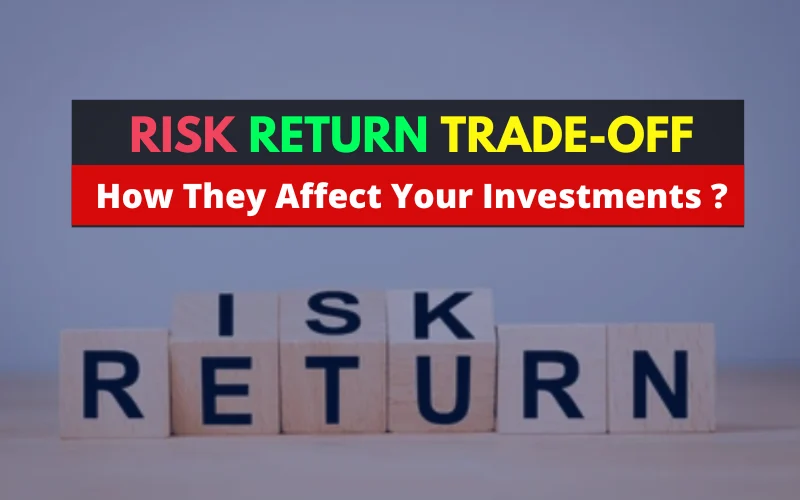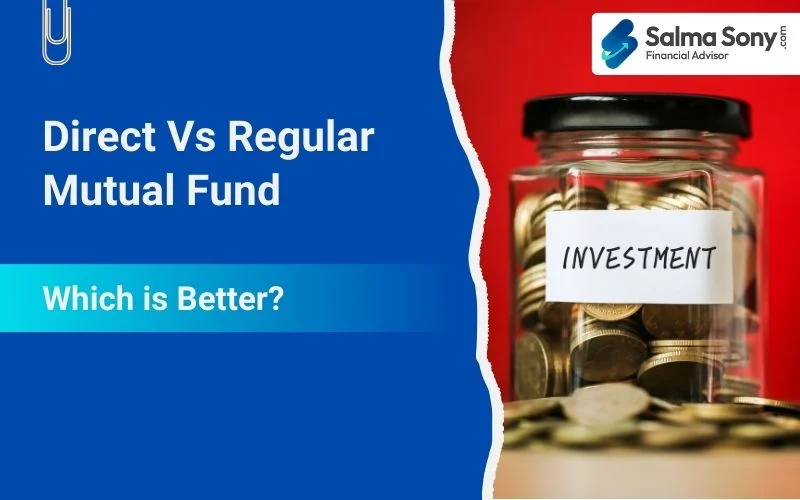Investing is a crucial aspect of financial planning and wealth building. In the world of investing, there is no free lunch. As an investor, you must know your investment is always associated with risk. To understand it better, let’s delve deep into the risk-return trade-off and explore how it affects your investments.

Understanding the Risk Return Trade-Off
The risk return trade off is the basic concept in investing that highlights the relationship between the level of risk associated with an investment and the potential returns it offers. Simply put, the higher the risk, the higher the expected return, and the lower the risk, the lower the expected return.
Here, you can understand the following example:
- Investment option 1: Debt investments like FD, RD, and post office instruments are associated with lower risk and lower return. Post office instruments are backed by sovereign gold; hence, your principal is risk-free but associated with the risk of further lower interest rates every quarter.
- In debt investing, you cannot expect more than 7.5% – 8% return p.a. (best case).
- Investment option 2: Equity investments like direct stocks or equity mutual funds are associated with higher risk and higher expected return. Your principal is at risk, and the return is not inevitable. There is no assurance of how much could be expected return; hence, monitoring the portfolio becomes an important exercise.
- In equity investing, the risk associated will also depend upon which category (large-cap, flexi-cap, mid-cap, small-cap) you are investing. In this, you can expect 10% – 12% return p.a. (based on the selected category).
Risk and Return: You Can’t Have One Without the Other
Risk and return are buddy and directly related. You can’t have one without the other.
Risk in Investing
Risk, in investing, refers to the uncertainty and volatility associated with an investment. Let’s break down their key components:
Risk in Debt Investments
- Inflation Risk: Investment in debt instruments is exposed to inflation risk as the expected return is lower than inflation.
- Reinvestment risk: Debt often allows investors to re-invest upon maturity. However, upon maturity, the reinvestment interest rate depends upon the prevailing interest rate. Suppose you invested in FD at 7% p.a. for three years and opted for a reinvestment option. After three years, your FD will get re-invested at the prevailing interest rate at that time, and if the interest rate is lower, reinvestment happens at a low-interest rate.
- Default/credit risk: Default or credit risk refers to the risk that debt issuers may default on interest and/or principal payments. Government securities are free of default risk, but all other debt is exposed. That’s why government bond coupon rates are comparatively lower than corporate bonds. Returning to basics lower the risk, lower the return, and vice-versa.
- Liquidity risk: Liquidity depends upon the types of debt instruments. If you are investing in debt mutual funds, online FD, or online RDs, liquidity is a click of a button. In contrast, if you have invested in bonds, it has limited liquidity in the secondary market.
Risk in Equity Investment
- Price Volatility Risk: This equity is exposed to price volatility, causing your investments’ value to rise and fall dramatically. That’s why anyone investing in equity directly or via mutual funds should have long-term vision, patience, and discipline. The equity market is not for making quick money but for long-term wealth creation.
Return in Investing
Return is the financial gain (or loss) an investor realizes from an investment over a specific period. It is usually expressed as a percentage and can come from various sources:
Return on Debt Investment
- Fixed Income: The debt investment is a good option for someone looking for a regular fixed income. For investors, such as retired persons, the fixed income from debt is ideal as it provides safe and sure returns on investment.
Return on Equity Investments
The return to an investor in equity is in two forms – dividend and capital gain.
- Dividend: If you hold direct stocks or opt for the dividend payout option in mutual funds, dividends get credited to your bank account periodically and value based on dividend declaration.
- Capital Gain: Investing in equity shares of a company means investing in the future earning capability of the company. If you invest in direct stocks or opt for growth options in mutual funds and upon sale, if you make a profit, that’s known as a capital gain. However, if you sell at a loss, then it’s known as capital loss.
Risk Tolerance Assessment for Investing
In investment, investors often ignore the risk associated with the investment, look for only return potential, and make investment decisions based on greed to earn higher returns. Assessing your risk tolerance level is a must in investing. Risk tolerance measures how much risk you are comfortable taking in your investment portfolio. It’s influenced by several factors, including:
- Financial Goals: Understanding your reason for investing is a must; we call it financial goals. Are you investing for emergency funding, short-term goals like vacation, or long-term goals like retirement planning? Financial planning is the right approach to understanding all your goals and risk tolerance and making appropriate investment decisions.
- Time Horizon: The time you plan to keep your investments is crucial. Longer time horizons typically allow for more risk-taking because you have more time to recover from market downturns.
- Current Financial Situation: Your current financial standing, including income, savings, and existing investments, can influence your risk tolerance. Someone with substantial savings and low living expenses may be more willing to take on risk.
- Psychological Factors: Your emotional response to market fluctuations is another critical element. If you’re prone to anxiety or panic when your investments dip in value, you might prefer a lower-risk portfolio.
To understand your risk tolerance accurately, I (SEBI Registered investment advisors) use questionnaires that help me analyze your willingness and ability to bear risk. The results guide the development of a financial planning investment strategy customized to your unique situation.
Matrics Used to Analyse Risk-Return Trade-Off in Mutual Funds
a)Alpha: Alpha is the excess returns compared to the market benchmark for a given amount of risk the scheme takes. The higher the alpha, the better the fund manager’s performance.
b) Beta: Beta measures the fund’s sensitivity to the market. The Beta of the market is 1. A fund’s Beta of more than one indicates a wide swing in the value of an investment in response to ups and downs in the benchmark’s value and a narrow swing for a beta of less than 1. The lower the Beta, the less sensitive, and the better it is for the investors.
c) Sortino: Sortino ratio measures the fund’s ability to control loss (downside protection) during the market correction. The higher the Sortino ratio, the better the fund can prevent losses. A Sortino ratio of more than one is acceptable.
d) Standard deviation: It measures the total volatility of a fund. The higher the standard deviation, the more volatile the fund. A lower standard deviation is better. While shortlisting the funds, look for funds with lower Standard deviation.
Balancing Risk and Return in Your Portfolio
Diversify Your Investments
Diversification is a fundamental risk management strategy. It involves spreading your investments among different asset classes, such as equity, debt, real estate, and gold. Diversification helps reduce the risk associated with individual investments and can lead to a more stable portfolio.
Set Clear and Realistic Goals
Before you start investing, it’s crucial to define your financial goal and choose investment accordingly. However, the common practice is to invest hard-earned money by looking at fund performance/ return without understanding how that specific investment works and then trying to know if it was an appropriate investment decision.
Setting clear and realistic goals will guide you in the approach you can take, balancing risk and return in your portfolio.
Consider Professional Advice
Suppose you are unsure about your risk tolerance level or how to construct a well-balanced portfolio. In that case, consulting a SEBI Registered Investment Advisor to help you with financial planning will be wise. They can assess your circumstances and recommend an investment strategy that aligns with your goals and risk tolerance.
Risk Return Trade Off Challenges
Overconfidence
Overconfidence in taking higher risks can hurt your financial situation. Generally, in a bull market, all the investors are overconfident about taking more risk that changes with market conditions. Hence, keeping your emotions detached and taking calculated risks based on your goals and risk tolerance level is better.
Chasing High Returns
The desire for high returns can tempt investors to take on more risk than they should, leading to financial difficulty if the investments don’t perform as expected.
Neglecting Diversification
Diversification is a fundamental risk management strategy. Pulling all eggs into the same basket could be very dangerous. Hence, pay attention to diversifying your investment in different asset classes.
Neglecting Changes in Risk Tolerance
Your risk tolerance can change over time due to life events, financial circumstances, or shifts in your investment goals. Neglecting changes in risk tolerance can impact your financial goals in a big way.
Conclusion
The risk-return trade-off is a fundamental concept in investing that underlines the relationship between the level of risk and potential returns. Balancing risk and return is crucial to constructing an investment portfolio that aligns with your financial goals and risk tolerance.
Remember, there is no one-size-fits-all approach to investing, and what’s right for one person may not be suitable for another. Hence, invest in what’s best for your goals and risk appetite. It is personal finance, do not genralize it.





